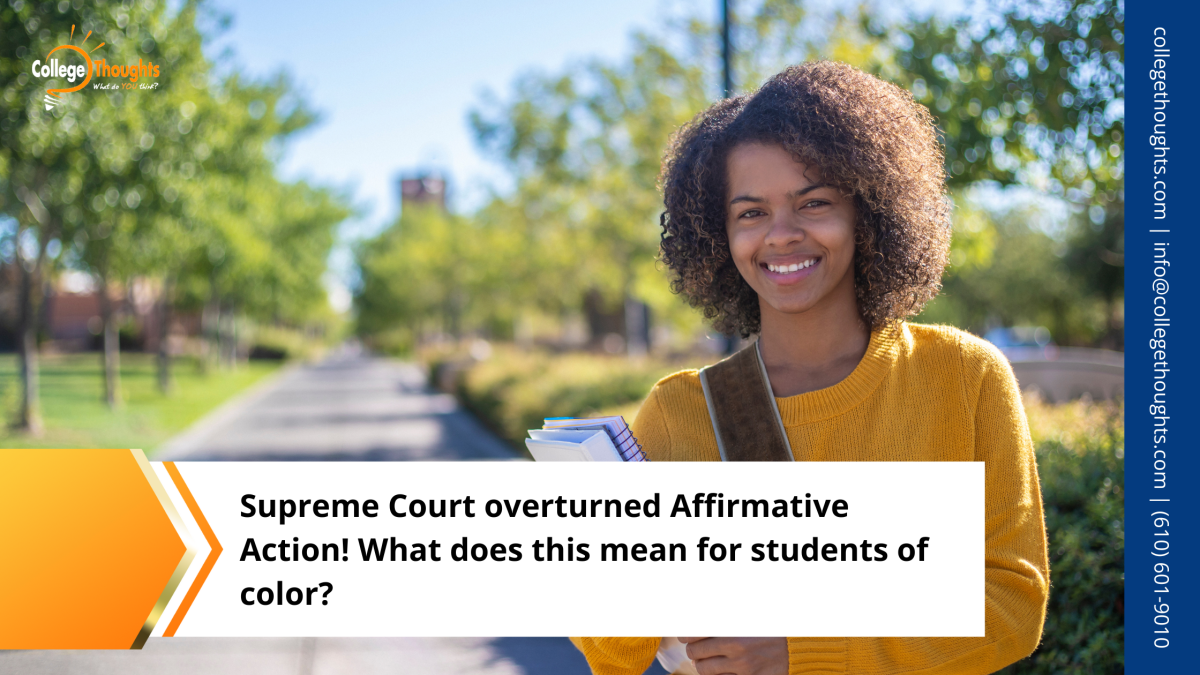Alexis – Stanford University
June 5, 2023
The New Digital SAT: How do you prepare for success?
September 25, 2023The ruling by the Supreme Court’s ruling to overturn Affirmative Action has prompted many questions about what this will mean for students of color. While this policy has been widely contested for decades, there have been some clear benefits because of its implementation, so naturally there are concerns about what will happen in its absence. First, however, let’s get into a little bit of background information to better understand the impact of Affirmative Action.
- What is Affirmative Action?
As a legal policy, Affirmative Action wasn’t initially constructed as a policy to directly affect college admissions. It was actually enacted in 1961 to counter past, present, and future discrimination in the workplace. Any and all businesses that received federal funds had to abide by this law and prove their compliance. The policy was implemented to ensure that applicants weren’t being unfairly rejected due to race, gender, sexual orientation, religion, age, or disability. In essence, Affirmative Action was put in place to ensure that all applicants had equal access to job opportunities and that they were treated fairly within the workplace.
- How was it used in college admissions?
In response to the changing landscape of employment, a number of colleges and universities took it upon themselves to create their own version of Affirmative Action policies. Though not federally required to do so, in the 1960s and 1970s, some schools set up admissions quotas as a way to ensure a racially diverse student population. For example, they might set aside 10% of the spots for African American students and another 5% for Latino students. However, with the Supreme Court case Regents of the University of California v. Bakke, the use of quotas was outlawed and deemed unconstitutional. In this case, they found that using race as the sole basis for admissions decisions was a violation of the 14th amendment and the Civil Rights Act of 1964, so colleges adjusted their policies to be more holistic. Rather than using race as the sole diversity metric, colleges used other indicators, such as socioeconomic status, so that students were no longer accepted or denied based solely on race.
- What does the Supreme Court decision mean?
Earlier this summer, the Supreme Court heard two cases about affirmative action: Students for Fair Admissions v. President and Fellows of Harvard and Students for Fair Admissions v. University of North Carolina. In both cases, Students for Fair Admissions were seeking to completely eliminate race-conscious admissions policies altogether. They argued that due to affirmative action policies, students from African American, Hispanic, and Native American backgrounds were given preferential treatment at the expense of White and Asian students.
In this historic decision, the Supreme Court declared both schools’ affirmative action policies unconstitutional, thereby overturning a 2003 decision to allow schools to consider race as part of a student’s application profile. With this decision, schools can no longer use Affirmative Action policies as part of the college admissions process. Judges in support of this decision argued that these policies were unconstitutional because they didn’t provide any objectives to warrant the continued use of race in admissions. They concluded that these policies relied more on “racial stereotyping” without any useful purpose, which violates the Equal Protection Clause. From their perspective,, and for others who oppose affirmative action, repealing the policies will make admissions purely merit based.
- How will this affect college admissions?
The current answer is we just don’t know. Some experts are predicting that we’ll see a decline in the number of African American, Hispanic and Native students attending colleges, especially elite institutions, as a result of this decision. However, that is still speculation. What we currently know is that while schools can neither admit nor deny students based on race, it doesn’t bar students from still including an essay about how their race or culture has impacted their life. Additionally, this latest ruling only bars using race as a factor, but still allows schools to use other factors such as gender, nationality, or socioeconomic status when making a decision.
If you’re currently preparing to apply to college, one thing you should focus on is research. In light of this decision, schools are rethinking their Affirmative Action policies and are likely to put such information on their websites. It’s worth taking the time to read through each schools’ admissions policies to better understand how your application will be read and reviewed. Additionally, you should continue working to improve and perfect the other portions of your application. Striving for the best possible test scores and most well written essays is still the best way to improve your chances of admission.
Looking for more information? Here are some more articles about affirmative action:
- NPR – Supreme Court reverses Affirmative Action
- AP News – Divided Supreme Court outlaws Affirmative Action
Want to speak to someone about how to perfect your application? Sign up here to speak to one of our team members!





